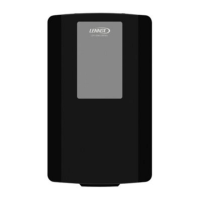Page 9
Installation (continued)
Bypass Damper Sizing
7. Install the dampers. Power close, spring open
dampers are preferred. Refer to the instructions
provided with the damper.
18 AWG thermostat wire minimum recommended.
8. Re-install the cover on the base.
When fewer than the maximum number of zones are
calling for heating or cooling, an excess volume of air is
delivered, and because of the excess air, an excess
amount of static pressure is produced as well. Zone
systems often require a bypass duct to relieve this
pressure. A properly sized barometric bypass damper
must be installed in the bypass duct which is run
between the supply and return air duct systems (see
Figure 4). The barometric damper and the bypass duct
must be sized to accommodate the excess static
pressure from the supply duct.
The bypass tap in the return air duct must be at least 6
ft. from the furnace /air handler to ensure that the hot or
cold air coming off of the plenum has time to mix with
the return air before it passes through the air handler
again. The provided discharge air sensor (field installed)
protects the equipment from overheating or coil
freeze-up by interrupting the HVAC equipment.
The bypass damper and duct should be sized to handle
the excess pressure created when the smallest zone is
operating alone (worst case). To size the bypass
damper, subtract the total air volume capacity of the
smallest zone from the total air volume of the system.
Example:
Total System air volume: 2000 cfm
Air volume of smallest zone: 600 cfm
Bypass requirement: 2000 - 600 = 1400 cfm
In this example, the bypass duct should be sized to
handle the 1400 cfm excess pressure created when
only the smallest zone has a demand. For bypass
damper air volume capacities, see Table 6.
Refer to the parts and supplies catalog for information
on available barometric bypass dampers.
FIGURE 4 – BYPASS DAMPER INSTALLATION
6 ft. (1.8 m)

